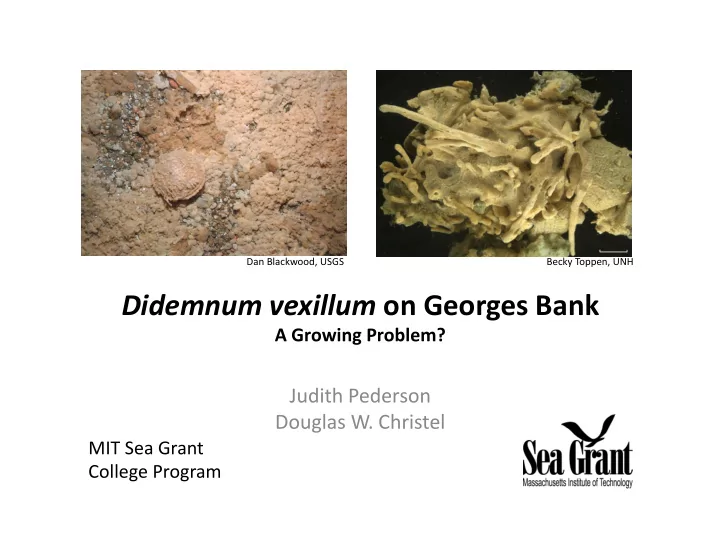

Dan Blackwood, USGS Becky Toppen, UNH Didemnum vexillum on Georges Bank A Growing Problem? Judith Pederson Douglas W. Christel MIT Sea Grant College Program
Purpose of Survey 1. Find out what fishermen know about Didemnum • Where it is found on Georges Bank • How it spreads • How it affects other species and vessel operaLons 2. IdenLfy potenLal ways to minimize impacts 3. Improve public educaLon about this species Dan Blackwood, USGS Dan Blackwood, USGS
What Is Didemnum ? • A sea squirt, or tunicate • Filter‐feeder • Forms colonies with other sea squirts • Tan, pink or yellow in color • Non‐naLve species
It Is Not “Monkey Dung” • Monkey dung is a sponge; Didemnum is a sea squirt • Monkey dung is bright yellow; Didemnum is more pink in color • Monkey dung has fewer siphon holes or cloacal bumps • Monkey dung sLcks together beWer; Didemnum will crumble Monkey Dung Didemnum hWp://habcam.whoi.edu Larry Harris, UNH
Didemnum Preferences Hard surfaces (starts on undersides) • Vessel hulls • Rocks/cobble • Lobster traps Moderate temperatures J. Dijkstra (10‐25°C, or 50‐77°F) • Dies back in winter, but can survive cold temperatures Depths up to 70m (230’, 35 fa) Cannot tolerate fresh water Gretchen Lambert
ReproducLon and Predators ReproducNon Predators • Periwinkle snails • Sexual reproducLon • Sea urchins • Asexual budding • Some fish species • Colony fragmentaLon Dan Blackwood, USGS
BoWom Types on Georges Bank C. Adams.MITSG
Where Has It Been Found? Northern Edge Page ValenLne, USGS
Causes of Movement Mostly human‐oriented • Ballast water • Hull fouling Ashley CouWs, USGS • Aquaculture • Breaking up colonies – Anchoring – Trawling/dredging Gretchen Lambert – Using lobster traps in mulLple areas Gordon King, USGS • Other sources?
PotenLal Problems Fast‐growing colonies blanket boWom surfaces Dan Blackwood, USGS
PotenLal Problems Overgrows naNve species, including scallops, mussels, worms • Reduces food available for groundfish and lobsters • May reduce movement of scallops Reduces larval recruitment • Overgrows habitats used as nurseries/predator avoidance • May prevent scallops from seWling on the boWom Increased labor costs for vessel and aquaculture operaNons • May increase Lme to shuck scallops • May increase need to clean gear Reduced yield of seafood • May slow growth rates for groundfish • May reduce survivability of shellfish Other issues we’ve missed? Dan Blackwood, USGS
Possible MiLgaLon Measures Fish more in areas where found Close areas where found Clean hulls/gear more frequently • Scrape hulls at least once a year www.derm.qld.gov.au • Clean traps frequently or reduce soak Lmes • Treat traps in warm/hot freshwater before sebng Minimize use of gear in other areas Discard scallop shells where dredging occurred Any other ideas?
Thank You! Your input is very helpful to our research. • Increases our knowledge of species interacLons • Puts issues into perspecLve • Helps refine research quesLons • IdenLfies pracLcal soluLons Contact informaNon: Dr. Judith Pederson • Telephone: 617‐252‐1741 • Email: jpederso@mit.edu • Website: hWp://seagrant.mit.edu
Recommend
More recommend